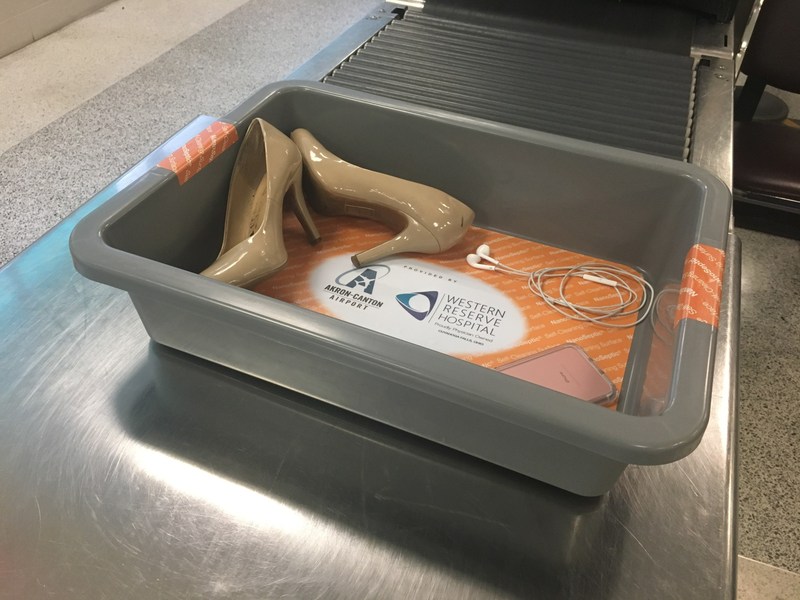by Brianna Crandall — September 8, 2017 — Facilities managers (FMs) who are looking for safe ways to reduce germs on high-touch surfaces may want to take note of this up-and-coming technology that has now entered the airport market.
One opportunity for extending cleanliness at airports is the set of bins used in security checkpoint lines. Last week, in what is said to be a first among the world’s 9,000 airports, the Akron-Canton Airport (CAK) announced that it had launched a nanotechnology solution that uses light to clean checkpoint bins 24/7.

The self-cleaning NanoSeptic skins are applied like stickers to the checkpoint bins’ handles, and the 1/16-inch-thick, self-cleaning mats cover the bottoms of the bins. (PR Newswire photo / Western Reserve Hospital)
Sponsored by Western Reserve Hospital and developed by NanoTouch Materials, new specially designed NanoSeptic mats and skins for the checkpoint bins contain mineral nanocrystals. They create a self-cleaning oxidation reaction that the company claims is stronger than bleach, and that continuously breaks down organic contaminants.
Rick McQueen, president and CEO of the Akron-Canton Airport, commented:
Travelers’ health and happiness is a priority of ours. Our employees pride themselves on holding high standards for the cleanliness of the airport, and there is a lot of hard work that goes into meeting those standards. We’re proud to be the first airport to implement this product because it’s one more way CAK continues to be a better way to go.
Western Reserve Hospital, an independent, physician-owned hospital in Cuyahoga Falls, is providing the self-cleaning skins and mats as part of its commitment to community health and safety. The skins are applied like stickers to the checkpoint bins’ handles, and the 1/16-inch-thick, self-cleaning mats cover the bottoms of the bins.
NanoTouch Materials, based in Forest, Virginia, has supplied self-cleaning skins, mats and other surface covers to the healthcare, commercial cleaning, education and other industries for three years. This launch at CAK is the first use of the technology in an airport.
Dr. Robert Kent, president and CEO at Western Reserve Hospital, remarked:
This initiative reflects our commitment to support the health of our community far beyond our hospital walls. It also exemplifies the type of community health innovation our independent physician owners seek to execute. As many of our patients travel through CAK, we are pleased to be a partner in this effort.
Dennis Hackemeyer, cofounder of NanoTouch Materials, stated:
Delivering self-cleaning surfaces in high-traffic areas like TSA security improves traveler experience and public perception of cleanliness while traveling. Additionally, we’re empowering the consumer by offering portable mats that can be used throughout their travels. These mats are also a tremendous opportunity for hotels, cruise lines, airlines and travel agencies to provide a new high-value amenity in rooms, while concurrently extending their brands.
NanoSeptic skins and mats turn dirty, high-traffic, public touchpoints into continuously self-cleaning surfaces, says the company. Powered by light, NanoSeptic surfaces utilize mineral nanocrystals that create an oxidation reaction said to be stronger than bleach. Working 24/7, the surface continually oxidizes organic contaminants. Unlike traditional disinfectants and cleaners, the NanoSeptic surface uses no poisons, heavy metals, or chemicals, and nothing is released from the surface since the nanocrystals are molecularly bonded to the material.
All NanoSeptic products are made in the USA, along with a grant-funded research and development lab, and NanoTouch Materials says its mission “to create not just a clean world, but a self-cleaning world!” is being embraced worldwide with the help of distributors in 30 countries.




